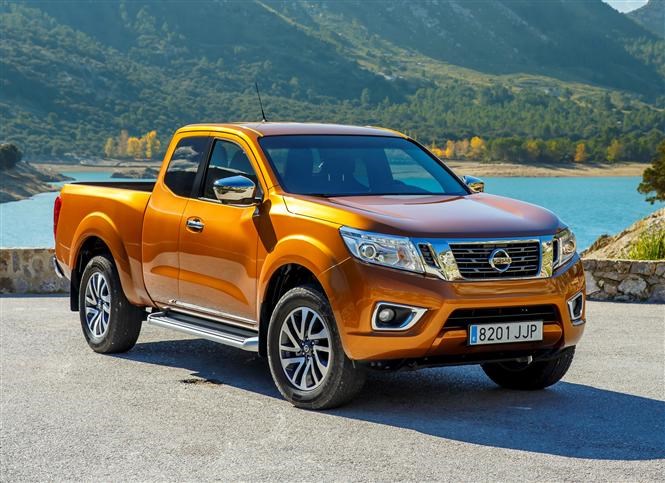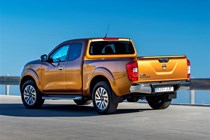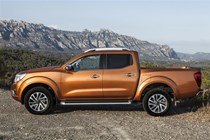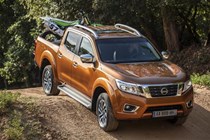Nissan has updated the engines in its NP300 Navara pickup truck ahead of the changeover to Euro 6 emissions legislation, which comes into force on 1 September 2016. The update, which affects both the 190hp twin-turbo and the 160hp single-turbo versions of the Navara’s 2.3-litre diesel motor, brings better fuel economy, class-leading CO2 emissions and an increased payload.
Nissan has also taken the opportunity to enhance the Navara’s standard equipment at the same time.
To read more about what Euro 6 means for vans and pickups, click here
What’s the bad news about Euro 6 for the Nissan Navara?
As with the majority of LCV makers, Nissan is using a Selective Catalytic Reduction (SCR) system to meet the new regs, which are particularly keen on reducing NOx (oxides of nitrogen) emissions. The main impact of this is the addition of a 17-litre AdBlue tank, leading to an increased kerbweight (5-38kg depending on model) and a reduction in the size of the regular fuel tank, which drops from 80 litres to 73 litres.
So now there’s another fluid to keep topped up in addition to diesel, engine oil and coolant, adding to running costs. According to Nissan, however, 17 litres of AdBlue should last you 7,150 miles, and you’ll get an automatic warning on the Navara’s LCD instrument cluster whenever it needs replenishing. A second filler flap on the opposite side of the pickup aims to prevent any confusion between where you put the AdBlue and where you put the diesel.
Unlike with some other manufacturers, there’s no associated increase in engine performance to compensate for the extra weight and inconvenience. However, since the Nissan’s 2.3-litre engine was specifically developed for commercial vehicles and is already one of the best performers in its class, there’s really little cause for complaint.
Click here to read Parkers’ full expert review of the Nissan NP300 Navara
What’s the good news about Euro 6 for the Nissan Navara?
Euro 6 technology is supposed to make vehicles more efficient, and on paper the Navara’s already class-leading mpg figures have improved, with the entry-level, two-wheel drive Visia King Cab version with 160hp now up 1.4mpg to 46.3mpg combined. The range-topping 190hp four-wheel drive Double Cab versions see a 0.8mpg improvement to 44.9mpg (41.0mpg for the seven-speed automatic, up 0.7mpg).
There’s also a welcome drop in CO2 emissions, with the basic Visia model falling 8g/km to 159g/km.
Even better news is that Gross Vehicle Weight also goes up by 25-35kg, offsetting the kerbweight increase on all but the Visia and Acenta 4x4 Double Cab models. In fact, payload actually goes up in most cases – and by as much as 20kg on that entry-level, two-wheel drive Visia King Cab variant.
It’s also worth noting that the Navara’s 3.5-tonne towing capacity remains unchanged, though the combined payload and towing rating is slightly reduced in some cases due to the higher kerbweight.
What else is new for the updated Nissan Navara?
All NP300 Navaras with the standard six-speed manual gearbox now get an Idle-Stop System, a stop-start system that switches the engine off when you’re at a standstill to save fuel.
Meanwhile, standard equipment across the range now includes:
- Upgraded instrument display
- Cruise control with speed limiter
- Bluetooth hands-free audio
- Steering wheel mounted multifunction controls
The five-year, 100,000-mile warranty (second only to the 125,000-mile warranty on the Isuzu D-Max) carries on as before, as does the car-like multilink rear suspension fitted on all Double Cab variants.
Meeting Euro 6 rules doesn’t come cheap for manufacturers, and Nissan is passing some of that cost on to buyers, with Visia models up £792 and all other grades up £891 (both amounts excluding VAT). By our calculations, this means the NP300 Navara now starts at £23,787 plus VAT.
For more about Euro 6 regulations click here
Read the full Nissan NP300 Navara review on Parkers here
Find a used Nissan NP300 Navara for sale on Parkers by clicking here
Just so you know, we may receive a commission or other compensation from the links on this website - read why you should trust us.










